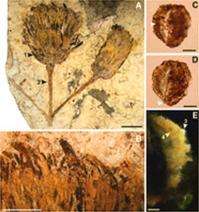September 28, 2010 report
Early sunflower family fossil found in South America

(PhysOrg.com) -- A beautifully preserved fossil identified as being of an early relative of the Asteraceae, or aster, family nearly 50 million years old suggests the plant family, which has now colonized much of the planet, originated in South America after Gondwana separated, forming South America, Australia, Africa, Antarctica and India.
Researcher Dr. Viviana Barreda and colleagues of the Argentinian Museum of National Sciences in Buenos Aires found the perfectly preserved fossil of two flowering heads in the north-west Pategonia region, in rocks along the river Picheleufu in what is now north-western Argentina, and dated it to 47.5 million years old. At the time the region was sub-tropical, with average temperatures of around 19°C.
Fossils of the Asteraceae are rare and most often only fossilized pollen grains are found, but the Patagonian fossil features two complete flowers complete with winged seeds, petals and the stems.
The most striking feature of the fossil, which resembles a painting of sunflowers by 19th century Dutch painter Van Gogh, is a dense flower head (capitulum) like that forming the central part of a sunflower and providing a strong attraction for pollinators.
According to Barreda, the finding and dating of the fossil suggest the ancestor of the Asteraceae probably originated in southern Gondwana, in a region that is now part of southern South America, before effective dispersal barriers were established within this massive supercontinent. It had been thought that the aster family originated from a common ancestor of the Asteraceae, Goodeniaceae and Calyceracea families in once-tropical Antarctica, migrating to Australia and South America as Antarctica cooled. Then, between 56 and 23 million years ago this common ancestor in South America branched into the Asteraceae and Calyceraceae. The new finding provides confirmation for this hypothesis.
Dr. Tod Stuessy, a botanist with the University of Vienna, who wrote an accompanying article to Barreda’s paper, said the fossil was clear evidence of the existence of the sunflower family at its early stages of diversification.
Stuessy said little is known about the origins of the sunflower family and there is much still to learn about its evolution and how it colonized the rest of the planet so quickly or how the members of the family became so “incredibly diverse.”
The Asteraceae family is the most diverse family of flowering plants, and includes sunflowers, daisies, chrysanthemums, lettuce, and dandelions among its members. The family includes 20-30,000 species, and representatives are found on every continent with the exception of Antarctica.
The paper and article describing the results of two years of work on the fossil are published in the journal Science.
More information: Eocene Patagonia Fossils of the Daisy Family, V. D. Barreda, Science 24 September 2010: Vol. 329. no. 5999, p. 1621. DOI:10.1126/science.1193108
© 2010 PhysOrg.com



















